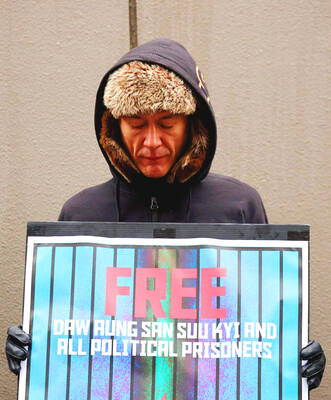Britain's leading evolutionary biologists are preparing to celebrate the 200th birthday of one of Charles Darwin's most ferocious opponents.
Richard Owen went to his grave believing Darwin was wrong to argue that life evolved by natural selection operating on random mutation -- but he also discovered the gorilla for science, identified the dodo, coined the word "dinosaur" and founded London's famous Natural History Museum in 1881. A special exhibition and a Richard Owen trail open at the museum today.
"This is not to say he was a nice character, because we know he wasn't," said Angela Milner, a palaeontologist at the museum and one of the organizers of the exhibition.
"Owen was an extraordinarily clever scientist, he was the leading comparative anatomist of his day, there is absolutely no doubt about that. He was a brilliant man, but he was also very competitive, very arrogant and he didn't want anybody taking his crown away from him," she said.
Richard Owen was born in Lancaster in northern England on July 20, 1804. He trained at Edinburgh, went to the Royal College of Surgeons and then moved to superintend the natural history collections of the British Museum in Bloomsbury. This priceless assortment of gems, minerals, dried plants, pickled fish and reptiles, fossils, skeletons, skins and stuffed mammals gathered by Captain Cook, Joseph Banks, Hans Sloane and other 18th century explorers was growing and deteriorating at the same time. Owen promptly began a 25-year campaign that climaxed in the present "cathedral of nature" in South Kensington.
He had originally enjoyed a working relationship with the younger Charles Darwin, but having been a devout Christian from the beginning, Owen saw creation as a series of experiments by a Creator, and he was outraged by Darwin's masterwork On the Origin of Species.
Owen was a tall, imposing figure with a charismatic public presence and a mission to educate: people flocked to his lectures. He hobnobbed with royalty and cultivated relations with the powerful.
"I suppose one could use the word snob, by today's standards," Milner said. "Darwin was a very shy, introvert, reclusive figure who didn't want any of this, whereas Owen was quite the reverse."
Owen also identified New Zealand's giant flightless bird, the moa or dinornis, from a piece of shin just 15cm long.
"It was a small fragment of tibia, but there was enough anatomy there for Owen to know that it was a bird bone, and there was just enough of the muscle scars on part of it for him to be able to place which bone it was. He deduced it must have been flightless," Milner said.
"And two or three years later when complete moa skeletons were discovered, he was proved to be spot on," he said.

The Burmese junta has said that detained former leader Aung San Suu Kyi is “in good health,” a day after her son said he has received little information about the 80-year-old’s condition and fears she could die without him knowing. In an interview in Tokyo earlier this week, Kim Aris said he had not heard from his mother in years and believes she is being held incommunicado in the capital, Naypyidaw. Aung San Suu Kyi, a Nobel Peace Prize laureate, was detained after a 2021 military coup that ousted her elected civilian government and sparked a civil war. She is serving a

China yesterday held a low-key memorial ceremony for the 1937 Nanjing Massacre, with Chinese President Xi Jinping (習近平) not attending, despite a diplomatic crisis between Beijing and Tokyo over Taiwan. Beijing has raged at Tokyo since Japanese Prime Minister Sanae Takaichi last month said that a hypothetical Chinese attack on Taiwan could trigger a military response from Japan. China and Japan have long sparred over their painful history. China consistently reminds its people of the 1937 Nanjing Massacre, in which it says Japanese troops killed 300,000 people in what was then its capital. A post-World War II Allied tribunal put the death toll

‘NO AMNESTY’: Tens of thousands of people joined the rally against a bill that would slash the former president’s prison term; President Lula has said he would veto the bill Tens of thousands of Brazilians on Sunday demonstrated against a bill that advanced in Congress this week that would reduce the time former president Jair Bolsonaro spends behind bars following his sentence of more than 27 years for attempting a coup. Protests took place in the capital, Brasilia, and in other major cities across the nation, including Sao Paulo, Florianopolis, Salvador and Recife. On Copacabana’s boardwalk in Rio de Janeiro, crowds composed of left-wing voters chanted “No amnesty” and “Out with Hugo Motta,” a reference to the speaker of the lower house, which approved the bill on Wednesday last week. It is

FALLEN: The nine soldiers who were killed while carrying out combat and engineering tasks in Russia were given the title of Hero of the Democratic People’s Republic of Korea North Korean leader Kim Jong-un attended a welcoming ceremony for an army engineering unit that had returned home after carrying out duties in Russia, North Korean state media KCNA reported on Saturday. In a speech carried by KCNA, Kim praised officers and soldiers of the 528th Regiment of Engineers of the Korean People’s Army (KPA) for “heroic” conduct and “mass heroism” in fulfilling orders issued by the ruling Workers’ Party of Korea during a 120-day overseas deployment. Video footage released by North Korea showed uniformed soldiers disembarking from an aircraft, Kim hugging a soldier seated in a wheelchair, and soldiers and officials